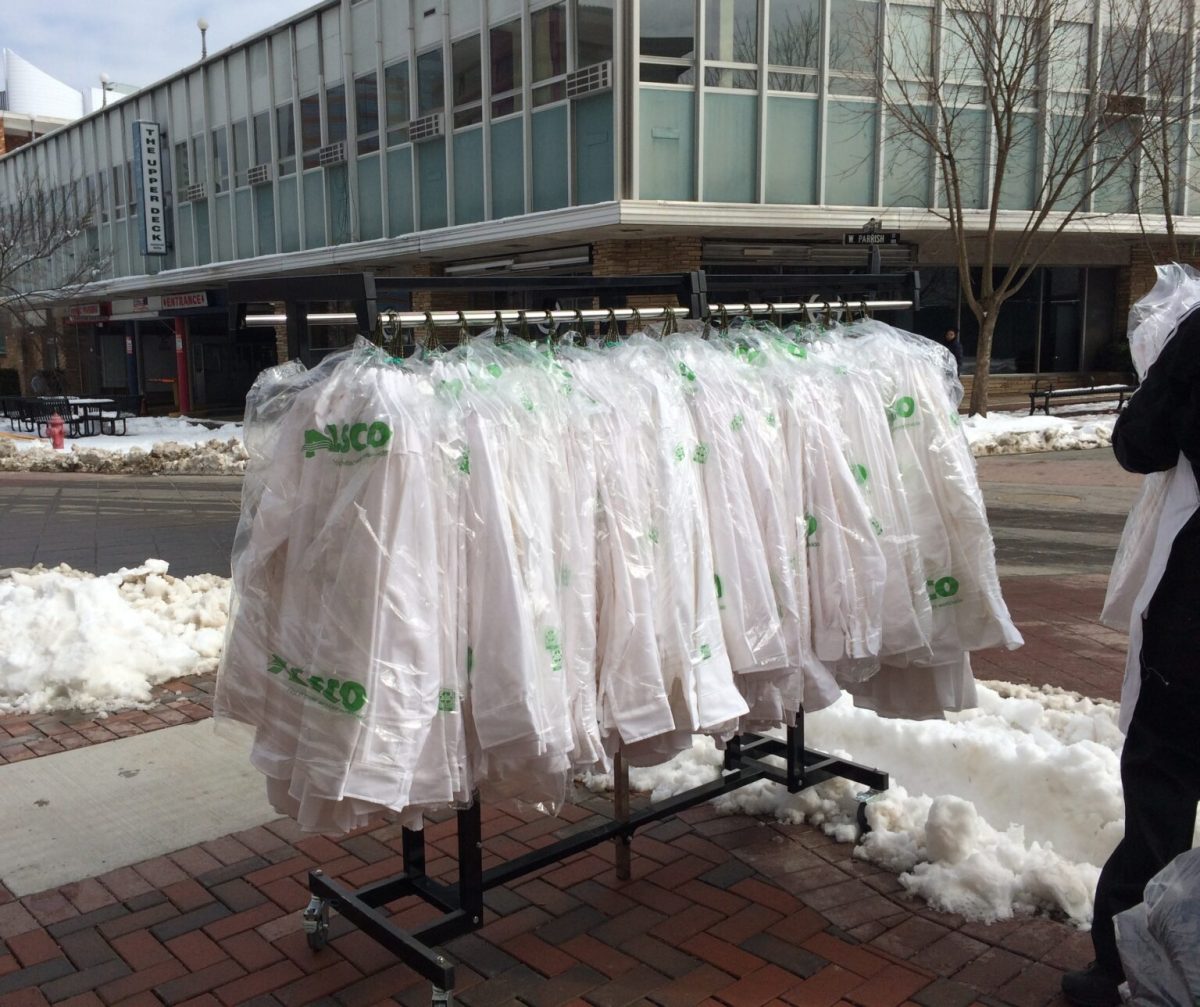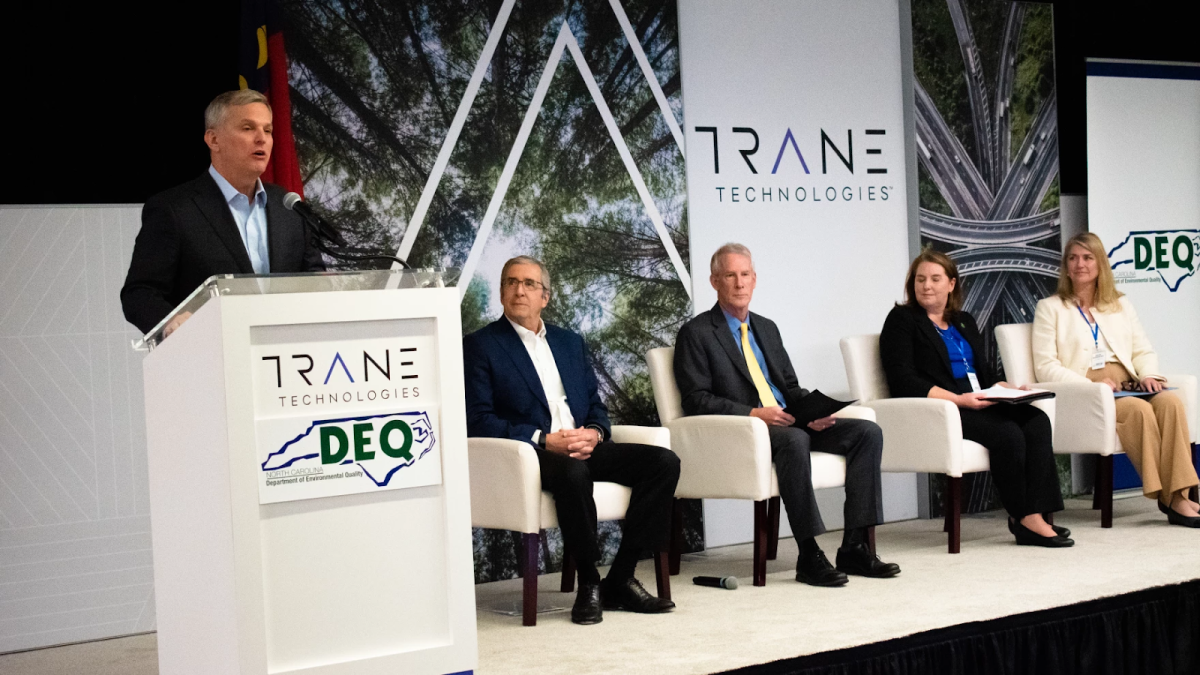Serious environmental hazards and health concerns regarding dry cleaning solvents have pushed many businesses in the industry towards eco-friendly alternatives. This growing demand for “green” dry cleaners has led to the rise of many companies claiming to be more sustainable than they are.
John Stauber, inspector of North Carolina’s Department of Environmental Quality (NCDEQ) Dry Cleaning Compliance Staff, explained that traditional dry cleaning involves processes using solvents that contaminate soil, groundwater and the air.
“The first … oldest and most common [solvent] is perchloroethylene (PERC),” Stauber said. “It tends to remain in the environment for long periods of time and doesn’t break down easily.”
Petroleum solvents are also often found in dry cleaning processes. They release toxic air pollutants and volatile organic compounds (VOCs) that can react to form ground-level ozone, or smog. Exposure to PERC and petroleum solvents is linked to various health risks such as cancer, asthma and neurological disorders.
Green dry cleaning is an eco-friendly way of cleaning your clothes without using harmful chemicals that pollute the environment and increase health risks upon exposure.
Various components of green dry cleaning allow it to be as effective as using normal solvents. Alternative solvents may include hydrocarbons, silicone oils, carbon dioxide or biodegradable solvents like citrus — all of which break down more easily in the environment.
Because of their natural composition, these solvents are also more gentle on fabrics, helping preserve the color and integrity of the clothing.
Green dry cleaning allows businesses to eliminate the hazardous waste that comes with utilizing PERC and petroleum solvents while still maintaining its traditional purpose.
“Green dry cleaning is better for the environment but also generally as effective as traditional dry cleaning — at least in removing stains and odors,” Stauber said.
The main problem is that it’s become difficult to distinguish dry cleaners that are legitimately green and those that are simply greenwashing.
Greenwashing is seemingly environmentally friendly marketing that uses deception to promote a company or product as being more sustainable than it is. There are many dangers in promoting normal dry cleaners as green, beginning with the fact that it’s simply unethical.
Winston-Salem’s Dry Cleaning Central (now Woshbox Cleaners), for example, openly claims to be eco-friendly, yet numerous Yelp reviews insist their clothes were ruined and reeked of fabric softener. (Editor’s note: At the time of publication, the Old Gold & Black could not reach out to Woshbox Cleaners for comment.)
The individuals behind the scenes supporting these dry cleaning businesses are important, as they hold a significant stake in the marketing approach used.
The North Carolina Association of Launderers and Cleaners (NCALC) is one of the few single-state trade associations representing and supporting the statewide dry cleaning industry.
Representatives from NCALC declined to comment when asked about their organization but their website provides general information on what they do. Their primary goal is to support dry cleaning companies that hold membership with NCALC, emphasizing educational outreach to improve their marketing approach and overall success.
“The NCALC wants to increase their membership,” Stauber said. “At the same time, they work with [NCDEQ] because they want to comply with state-specific dry cleaning regulations.”
He continued: “It also helps their case when they claim they work closely with NCDEQ because it makes them seem extremely eco-friendly, tying back into this idea of greenwashing. It’s one thing to meet regulations but another to go above and beyond.” Woshbox is a member of the NCALC.
The NCALC also declined to comment on whether or not they implement green dry cleaning practices in their educational outreach programs.
This is where NCDEQ steps in to help dry cleaning companies that require assistance recovering contaminated land.
NCDEQ helps dry cleaners through their Dry-cleaning Solvent Cleanup Act (DCSA) program. Chartered in 1997, the DCSA established a fund to assess and clean up solvent contamination at dry-cleaning distribution facilities and enforce rules to prevent solvent releases at operating facilities.
Stauber expanded on this with a real-life scenario.
“Let’s say you own a dry cleaning business that’s used PERC for 30 years. Your land is now contaminated, and no one wants to buy it because it’s full of hazardous substances,” Stauber said. “The state will help you by paying about 90% of your property’s cleanup cost. It’s similar to the brownfields program in that they attempt to recover these contaminated sites, so they aren’t just unused properties.”
As proven by NCDEQ, there is room for improvement in the dry cleaning industry to shift towards normalizing green dry cleaning and the resources to go about this process are available. At the same time, organizations like NCALC with significant influence within the industry must practice transparency and implement more eco-friendly educational outreach if the industry is going to change.












Brian Harrell • Nov 13, 2024 at 9:17 am
Thank you for highlighting the environmental aspects of dry cleaning practices and the industry’s efforts to innovate for a safer and greener future. As a long-time member of the industry, I appreciate the focus on environmental responsibility and want to offer some perspective on how dry cleaners tackle these issues head-on. While the article rightly points out the risks associated with perchloroethylene (perc), it may inadvertently simplify the discussion around other solvents, particularly petroleum-based options.
Today’s hydrocarbon solvents are not the petroleum solvents of the past; they’ve been formulated with a much lower VOC potential, which makes them considerably less impactful on the environment. That, combined with smart regulations and strict internal measures, helps mitigate risks to the quality of our air and groundwater, making hydrocarbon solvents a responsible alternative that better balances safety and performance.
The article’s tone might unintentionally give the impression that all non “green dry cleaning” solvents are equally harmful, which simply isn’t the case. Hydrocarbon solvents are significantly less toxic than perc, break down faster, and are a good option for dry cleaners committed to safety and environmental standards.
While “Greenwashing” in any industry is concerning, it’s important to recognize that responsible dry cleaners—and groups like the North Carolina Association of Launderers and Cleaners (NCALC)—have been leading the charge on genuine, sustainable change in our industry. NCALC has been instrumental in educating dry cleaners on transitioning to safer solvents and practices, setting high standards, and partnering with environmental programs like the Dry-Cleaning Solvent Cleanup Act (DSCA). Thanks to their leadership and dedication, North Carolina’s dry cleaners are taking real, tangible steps toward a cleaner, healthier future. This isn’t just about slapping a “green” label on the door—it’s about real commitments that make a difference.
I want to touch further on the Dry-Cleaning Solvent Cleanup Act (DSCA) program. The DSCA program was established with strong support from the dry-cleaning community. In fact, my predecessor and fellow Wake Forest alum, Chris Edwards, helped lead the charge in developing North Carolina’s clean-up. This program is an industry-led initiative that helps dry cleaners address contamination issues from traditional solvents like perc. Through annual fees, dry cleaners across North Carolina contribute to a fund that supports environmental cleanup. The DSCA program has been a game-changer for protecting local water and soil quality, providing financial assistance that covers over 90% of cleanup costs on eligible properties and ensuring ongoing regulatory oversight. Programs like the Dry-Cleaning Solvent Cleanup Act (DSCA) are proof of our industry’s dedication, from cleaning up legacy contamination to actively preventing future pollution.
It’s worth mentioning that dry cleaning has several other environmental benefits: we recycle and reuse cleaning solutions through distillation and filtration, rather than sending detergents straight down the drain, and we extend the longevity of fabrics, helping to reduce waste. These are meaningful advantages that don’t always get recognized in the broader environmental conversation.
While the shift toward greener methods is a priority, it’s a journey that takes time and a commitment to high standards in both service and environmental responsibility. We encourage customers to ask questions about the steps their dry cleaner is taking toward sustainability and environmental care.
Best Regards,
Brian Harrell
A Cleaner World, President
NCALC, VP Government Affairs
Wake Forest University ‘95